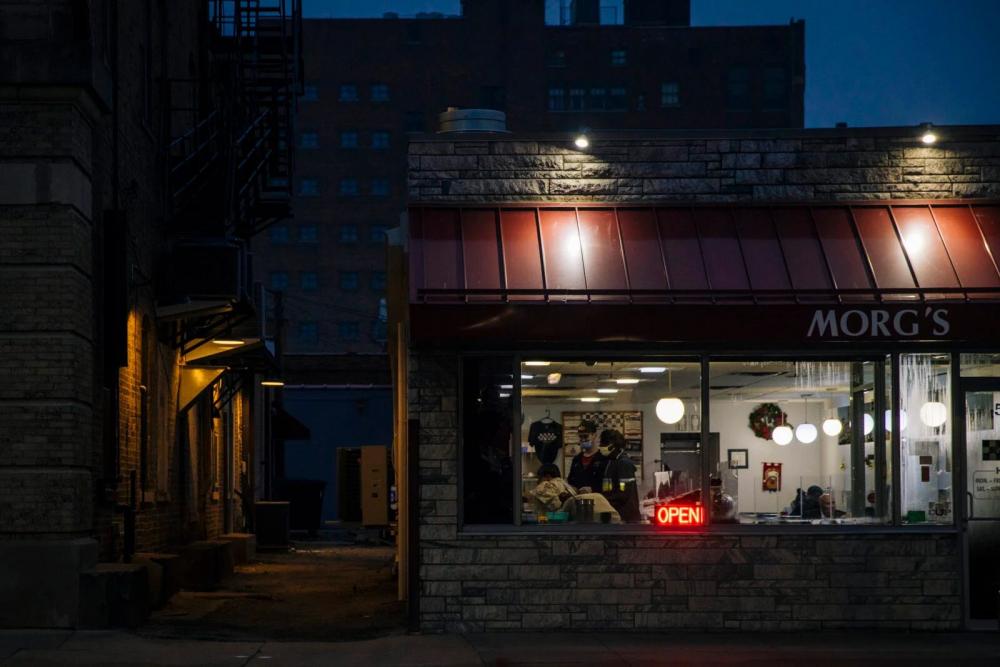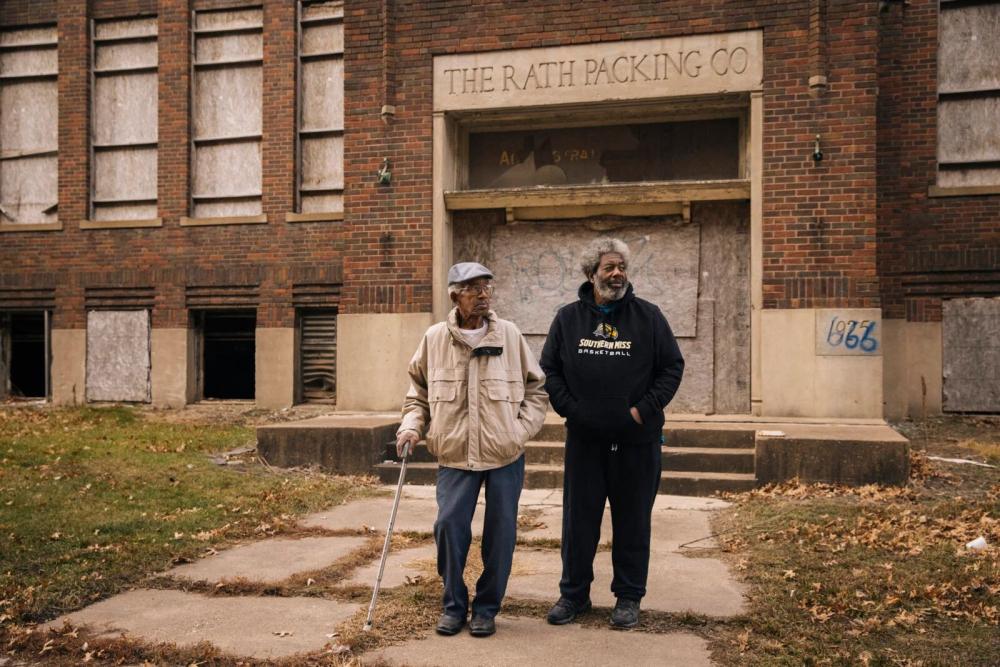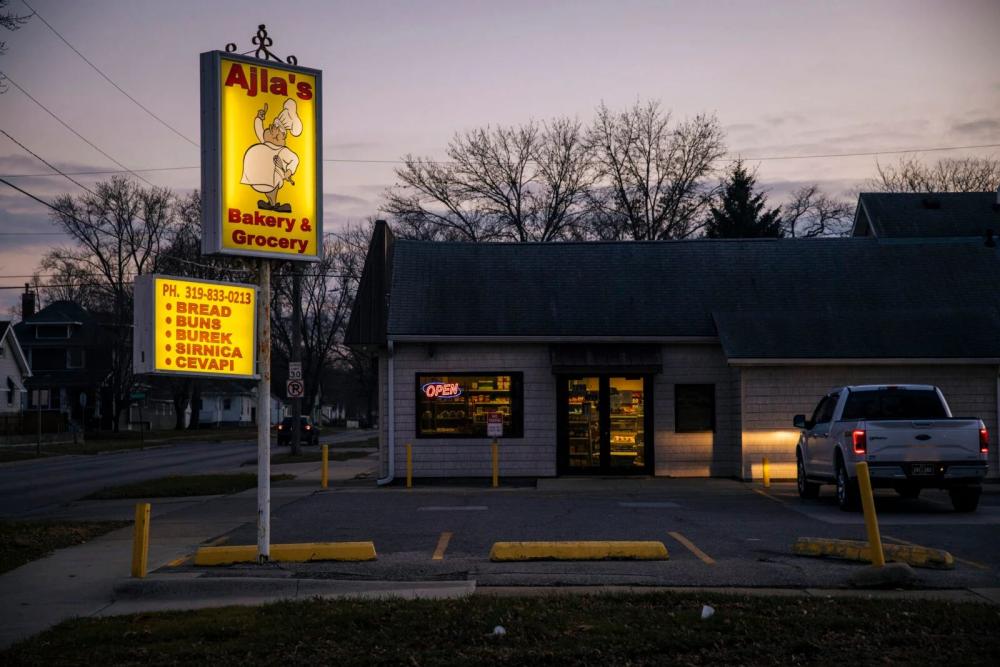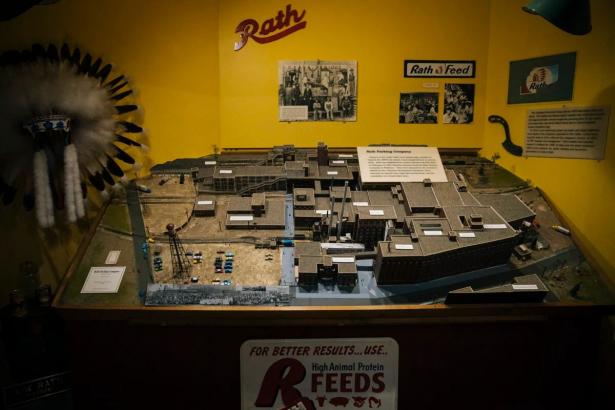How the History of Waterloo, Iowa, Explains How Meatpacking Plants Became Hotbeds of COVID-19
ProPublica is a nonprofit newsroom that investigates abuses of power. Sign up to receive our biggest stories as soon as they’re published.
This spring, Waterloo, Iowa, became the site of one of the largest — if not the largest — COVID-19 workplace outbreaks in the United States. At the sprawling Tyson Foods pork plant on the eastern edge of town, at least 1,500 of the 2,800 workers have been infected with the virus, according to the county sheriff, who also heads the emergency management commission. Eight of those workers died, he said, and based on contact tracing, the cases tied to Tyson grow to 2,500 to 3,000. Waterloo was, in many ways, primed for an outbreak, and the reason lies in its history, which reflects the meatpacking industry’s dramatic transformation over the past half century.
1891
The Rath Packing Company, a family-owned meat company, opens a pork processing plant in Waterloo on the banks of the Cedar River. From a modest brick building and 22 employees, it became one of the nation’s leading meatpackers and a major employer in Waterloo, which was then known as Iowa’s “Factory City.”
1911
Blacksmiths, boilermakers and other laborers at the Illinois Central Railroad’s repair shop in Waterloo lay down their tools and join a national strike. The walkout threatened to hamper train service throughout the Midwest. So, the railroad began importing strikebreakers, many of them Black workers from its Water Valley, Mississippi, shop. Over the next decade, hundreds of Black workers from the South would follow in their footsteps to Waterloo.
1917
During the world wars, Rath grows into one of the nation’s biggest meatpackers, thanks to lucrative wartime contracts and savvy ads catering to consumers’ appetite for canned meat. The company would become best known for its Black Hawk Bacon and vacuum-cooked Tend’r Ham.
1947
Congress passes the Taft-Hartley Act, allowing states to enact so-called right-to-work measures and placing limits on when workers can go on strike. The law strips workers of vital leverage, but fiery unions like the United Packinghouse Workers of America, which had organized Rath’s employees during World War II, would test it in the years to come. The union was ultimately successful, in part because of its belief that worker solidarity couldn’t exist without racial solidarity, an ideal symbolized by the union’s logo: a white hand clasping a Black hand.
1948
Rath employees walk off the job to protest wages and the Taft-Hartley Act, joining more than 80,000 meatpacking workers nationwide. The strike would have lasting impact on labor and race relations in Waterloo. In a defining moment, workers surrounded the car of a Black strikebreaker as he entered the Rath gate. They rocked the car back and forth and threatened to tip it over. The man grabbed a pistol from the floorboard and while waving the gun, shot and killed a white union member.
Waterloo braced for a riot. John Carr, who was 12 at the time, was playing with his best friend at the strikebreaker’s farm when it happened. “My sister came driving and screaming and hollering, ‘Get in the car! Get in the car!,’ because they was coming out to burn the farm down,” Carr, now 84, said in an interview. The workers targeted Rath and the replacement workers, prompting the governor to call in the National Guard. But the shooting didn’t fracture racial alliances, and Black and white union members marched together in the funeral procession for the slain worker. The strikebreaker was acquitted.

Morg’s, an iconic Waterloo diner, has been in business since 1945. (Taylor Glascock for ProPublica)
The UPWA takes its advocacy outside the plant and sues a Waterloo tavern owner for failing to serve Blacks. It was one of many tactics the union used to desegregate the city. One of its most effective strategies involved white workers going from tavern to tavern to order food and drinks. Their Black coworkers came in next. When the businesses refused to serve the Black workers, the white workers walked out. From the late 1940s through the ʼ60s, the union handled discrimination complaints at other workplaces, pressured hotels to desegregate, boycotted stores that wouldn’t hire Blacks and convinced the local newspaper to stop identifying race in crime articles only when the suspect was Black.
Jimmie Porter, a locally heralded civil right activist, was central to the union’s integration efforts. A native of Mississippi, he observed that while the racism in the North wasn’t as blatant, it also wasn’t too different from what he’d left. “I pretty well knew where I stood in Mississippi, and here, I had to be told and reminded,” he said in an oral history interview. “They had conditioned most of the Blacks who lived here to never look at how well they should be doing compared to whites who they had gone to school with, but to measure themselves by their country cousin.”
1954
Anna Mae Weems becomes one of the first Black women to integrate Rath’s sliced bacon department, a bastion of white women working in a pristine environment. Born in Waterloo, Weems couldn’t understand why, after graduating from high school, she couldn’t get the jobs that her white classmates were getting. The union recruited her to further challenge the race and gender barrier at Rath. She soon became the shop steward for the bacon line.
It had been a long fight to get there. Black workers had often been assigned to the dirtiest jobs in the packinghouse. Black women were overrepresented in hog casings departments, where they “flushed worms and feces from the animal’s intestines,” one historian wrote. Meanwhile, Black men were frequently assigned to the kill floor, though the position had unexpected advantages. Whenever there was a dispute, the workers could stop the line, threatening to let the hog carcasses rot until the company resolved their grievance.
1956
Rath’s employment peaks at nearly 9,000 workers. Thanks to the jobs at the packinghouse and at other factories, thousands of Black people moved to Waterloo from the South during the Great Migration. As Rath became an increasingly popular brand, the union ensured that the workers’ economic fortunes rose with it. By the mid-1960s, wages were the equivalent of $24 to $32 an hour in today’s dollars, helping create a Black middle class.
1967
An upstart company, Iowa Beef Packers, introduces a product known as “boxed beef,” transforming the meatpacking industry. Instead of sending sides of beef to butcher shops, IBP workers stood side-by-side, each making a specific cut to disassemble a carcass moving down a conveyor. “We’ve tried to take the skill out of every step,” IBP’s president had told Newsweek in 1965. The new process sped up production and allowed the company to move its plants from cities into rural areas where livestock was plentiful and unions were scarce. Most large meatpackers would follow suit.
1968
The UPWA merges with the more conservative Amalgamated Meat Cutters as corporate power grows in the changing meat industry.
1979
The meatpacking union joins an organization of retail and grocery clerks to form the United Food and Commercial Workers. Some meatpacking workers found themselves battling with their union as much as their employers. At some plants, members of old UPWA locals tried to push back against wage cuts, but the UFCW leaders sided with the meatpackers. “It was like a shot of whiskey. When we was the UPWA, we was little but powerful,” a union leader told oral historians. “Then we joined the Amalgamated and we got like a mixed drink. Now it looks to me like we’re a shot in a quart of Squirt.”
1985

John Carr, left, and Bennie Spain, at the ruins of the Rath plant, where they both worked before it closed. (Taylor Glascock for ProPublica)
After years of financial trouble, Rath shuts its doors, contributing to an economic tailspin in Waterloo that deeply affects the Black community. Simultaneously, the 1980s farm crisis had taken a toll on Waterloo’s other big employer, John Deere, which laid off thousands. As the last ones in, Black workers were now the first to go, erasing hard-fought economic gains.
The civil rights movement had spurred the desegregation of Waterloo’s schools, but as in other cities, it prompted white flight. Without good-paying jobs, many middle-class Black families also left for opportunities elsewhere. Those who stayed faced bleak prospects. “You could have a master’s degree and be in Waterloo, and if you were Black, it was hard for you to find a job,” said the Rev. Belinda Creighton-Smith, senior pastor of Faith Temple American Baptist Church.
1988
IBP announces its plan to build the world’s largest hog-slaughtering plant in Waterloo, promising 1,500 jobs for the struggling city. Many hoped it would provide work for hundreds of laid-off Rath employees, but some leaders had their doubts. The company had a reputation for mistreating workers and had been fined by the Labor Department for failing to report injuries. Willie Mae Wright, the only Black city council member at the time, was among those skeptical of IBP. But after meeting with community members, she said in an interview, she “went along with it knowing that people didn’t have jobs.” City officials approved the IBP plant.
1990
IBP’s slaughterhouse opens to much excitement in Waterloo. But many of IBP’s initial hires don’t stay on the job for long. Some told community leaders they were overwhelmed by the speed of the processing lines, which left their hands numb. After several years, few in the local workforce wanted to work there.
1996
IBP looks elsewhere for workers. It recruits homeless people from shelters and under highway overpasses. It hires labor agencies to find workers from the U.S.-Mexico border, and appeals to California farmworkers who want out of the hot fields and a lower cost of living.
IBP also runs a recruiting operation in Mexico, buying ads on local radio stations and turning pharmacies, stores and car washes into application centers. The company eventually charters buses to transport workers directly from Mexico to its plants. While IBP insisted the workers were authorized, dozens were detained in two immigration raids on the Waterloo plant.
1997

Ajla’s, a Bosnian bakery and market in Waterloo. (Taylor Glascock for ProPublica)
IBP recruits refugees from the Bosnian war. Over the next several years, about 3,000 would settle in Waterloo. One Bosnian woman recalled how company representatives had gone to a church in Chicago where she was taking English classes to show a recruiting video. She and others took the job. When they arrived in Waterloo, IBP took them to apartments arranged by the company. “We went to sleep,” she said in an oral history. “Then at 4 o’clock in the morning, there was a bus that was there and waiting for us. The bus took us to IBP and we worked there until 4 o’clock, 5, and then they took us back to our apartments.”
2001
Tyson Foods acquires IBP, allowing the chicken processing giant to expand into beef and pork. The move makes Tyson one of the world’s largest meatpackers.
2008
In nearby Postville, Iowa, a meatpacking plant is raided by immigration authorities, one of the largest workplace stings in U.S. history. The fairgrounds of Waterloo’s National Cattle Congress, the site of an annual agricultural fair, serves as both a staging ground and a temporary holding facility. The raid signals how dependent the industry had become on unauthorized workers.
2010
Tyson holds recruiting events in Rockford, Illinois, creating a flow of refugees from Myanmar who had been resettled in the United States. Immigrants from Africa, particularly the Democratic Republic of Congo, also begin arriving through the visa lottery. Many had been lawyers, teachers and journalists but found their credentials weren’t transferrable, and language barriers made it hard to find work outside meatpacking plants. Marshallese and Micronesian workers also landed in Waterloo after leaving their islands in part because of climate change.
2018
A financial news site, 24/7 Wall St., ranks the Waterloo-Cedar Falls metro area the worst place for Black people in America. The Black unemployment rate is nearly five times higher than for whites, and Black residents own homes at less than half the rate of white residents, the report notes. Despite the economic gains that meatpacking jobs had provided a generation earlier, Waterloo remains largely segregated, with a historically Black neighborhood bounded by railroad tracks on three sides. And many in the Black community haven’t fully recovered from the 1980s economic downturn.
2020

State Rep. Ras Smith, who represents the city’s east side. “I don’t want Tyson to overshadow what Waterloo is,” Smith said. (Taylor Glascock for ProPublica)
An outbreak at the Tyson plant makes Waterloo one of the country’s biggest COVID-19 hotspots. The disease disproportionately affects the city’s immigrants, refugees and communities of color — a demographic heavily employed by Tyson. “This is their first attempt to get a slice of this American apple pie and then for it to be so bitter for them is a travesty,” said state Rep. Ras Smith, who represents the city’s east side. “I don’t want Tyson to overshadow what Waterloo is.”
Mollie Simon contributed reporting.
Sources: Oral histories from the University of Iowa Labor Center, the United Packinghouse Workers of America oral history project and the Grout Museum of History and Science; academic papers and books written by Bruce Fehn of the University of Iowa, Roger Horowitz of the University of Delaware, Rick Halpern of the University of Toronto, local Waterloo historian Bob Neymeyer, Rebecca Conard of Middle Tennessee State University and independent scholar Herbert Plummer Jones; archived newspaper articles from The Courier of Waterloo-Cedar Falls; Rath Packing and IBP company records; and original interviews with former Rath workers and community leaders.
Bernice Yeung covers business with a focus on labor and employment for ProPublica.
Michael Grabell writes about economic issues, labor, immigration and trade. In 2019, he was part of a team that was a finalist for the Pulitzer Prize for public service.
Protect Independent Journalism
This story you’ve just finished was funded by readers of ProPublica. We hope it inspires you to make a gift to ProPublica so that we can publish more investigations like this one that hold people in power to account and produce real change.
ProPublica is a nonprofit newsroom that produces nonpartisan, evidence-based journalism to expose injustice, corruption and wrongdoing. We were founded over 10 years ago to fill a growing hole in journalism: Newsrooms were (and still are) shrinking, and legacy funding models are failing. Deep-dive reporting like ours is slow and expensive, and investigative journalism is a luxury in many newsrooms today — but it remains as critical as ever to democracy and our civic life. More than a decade (and six Pulitzer Prizes) later, ProPublica has built the largest investigative newsroom in the country. Our work has spurred reform through legislation, at the voting booth and inside our nation’s most important institutions.
Your year-end donation will help us ensure that we can continue this critical work into 2021. From COVID-19, to our elected officials, to racial and criminal justice and much more, we are busier than ever covering stories you won’t see anywhere else. Make your gift to ProPublica of any amount today and join the tens of thousands of ProPublicans across the country, standing up for the power of independent journalism to produce real, lasting change. Thank you.


Spread the word